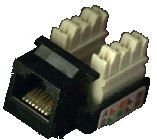
![]()
Ethernet Materials / Tools[ Ethernet
Home | Network Primer | Home Networking | Wireless Home Networking ] 10BaseT/100BaseT Ethernet MaterialsThe following Ethernet materials are listed in order from when an Ethernet connection starts at a computer's Network Interface Card and follows until it reaches an Ethernet hub.Network Interface Card (NIC)This is the peripheral card that you plug into a slot (ISA or PCI) inside your computer. This card connects your computer to the Ethernet network and allows it to communicate on it. Cards may be BNC and or TP. BNC uses coaxial cable, whereas TP, twisted pair uses cat 3 or cat 5 cable. In addition to ISA or PCI cards for desktops, external NIC's can be purchased that plug into a USB port. For notebook computers, PCMCIA Ethernet cards can be used.Patch Cable A patch cable is a cable that connects two jacks together. This would
be the jack on the network interface card and the jack in the wall plate.
These cables come in a variety of colors to suit your needs and blend
into the environment, if so desired. Each cable has 2 plugs, one on each
end.
A patch cable is a cable that connects two jacks together. This would
be the jack on the network interface card and the jack in the wall plate.
These cables come in a variety of colors to suit your needs and blend
into the environment, if so desired. Each cable has 2 plugs, one on each
end.
Wall PlateA wall plate is the plate that is put on the wall that covers an electrical box. In the wall plate, there are cutout rectangular areas where "keystone" jacks may be inserted. This modular design allows easy changing from RJ45, for Ethernet, to RJ11, for phone.RJ45 Jack An RJ45 jack is a receptacle for RJ45 plugs (patch cables). These"keystone"
jacks are snapped into places in the wall plate. The jacks are connected
to bulk cabling by a punch down tool.
An RJ45 jack is a receptacle for RJ45 plugs (patch cables). These"keystone"
jacks are snapped into places in the wall plate. The jacks are connected
to bulk cabling by a punch down tool.
Bulk CableBulk cable is used to connect wall plates to the patch panel. It comes in spools of 250', 500', 1000', and 5000'. There are 3 types of bulk cable: solid, stranded, and plenum. Solid cable is better for data transmission, and thus it should be used between the wall plate's RJ45 jack and the central patch panel. Stranded cable, on the other hand, doesn't transmit as well as solid, but has the benefit of flexibility. This type should be used for making your own patch cables. Lastly, plenum cable shall be used if the cable will be going through air ducts. In case of fire, plenum cable doesn't release toxic fumes into the air. Thus, there are building regulations mandating its use.One visitor corrected me on the definition of plenum cable: Actually a plenum is the area between a false ceiling and the true one in most commercial building and is used to circulate heating and cooling air. It's called plenum or the plenum space. Plenum-based cable's purpose is not the fact that it is more resistant to fire, but the fact that when burnt, it does not emit toxic fumes into the air. Patch PanelA patch panel consists of a board-like structure that allows keystone RJ45 jacks to be inserted, allowing the bulk cable leads to connect. A patch panel organizes all the cables and makes them easier to manage. Often times, the area where the patch panel is located is called the "wiring closet."Patch CablesSame as patch cables mentioned above, although cables used in the wiring closet tend to be shorter because they need only connect to the hub/switch nearby.Ethernet Hub/Switch/Router/BridgeA hub is where all the patch cables coming off the patch panel come together. Each patch cable is connected to a separate port on a networking device. Sometimes hubs will include a BNC or Twisted Pair uplink port to allow them to connect to other hub, without adding another network segment. Hubs with this feature are often called "stackable."Ethernet ToolsPunchdown ToolA punchdown tool is used to terminate the wires in a jack. Unless you plan on doing a lot of these, you don't need an actual punchdown tool (even the cheapest punchdown tools cost about $70). For less than $10 you can get a little black piece of plastic called a "pushdown tool" that has the cutouts for being a punchdown tool. The only difference between this and a real punchdown tool is that this doesn't have blades for cutting the wire. Also, a real punchdown tool has adjustable springs that prevent you from damaging the patch panel or wall jack by applying too much force. One visitor pointed out that Radioshack sells a pushdown tool for $5:
<< Back to Wireless, Home, and Ethernet Networking
Questions? Comments? Share your thoughts on the Discussion Forums...
|

|
Unless otherwise noted, all contents are copyright © 1997 through 2007 Zingtech Computer Solutions and Michael Matczynski (
Check out wineries at Catch Wine.com:
Alabama Wineries - Alaska Wineries - Arizona Wineries - Arkansas Wineries - California Wineries - Colorado Wineries - Connecticut Wineries - Delaware Wineries - Florida Wineries - Georgia Wineries - Hawaii Wineries - Idaho Wineries - Illinois Wineries - Indiana Wineries - Iowa Wineries - Kansas Wineries - Kentucky Wineries - Louisiana Wineries - Maine Wineries - Maryland Wineries - Massachusetts Wineries - Michigan Wineries - Minnesota Wineries - Mississippi Wineries - Missouri Wineries - Montana Wineries - Nebraska Wineries - Nevada Wineries - New Hampshire Wineries - New Jersey Wineries - New Mexico Wineries - New York Wineries - North Carolina Wineries - North Dakota Wineries - Ohio Wineries - Oklahoma Wineries - Oregon Wineries - Pennsylvania Wineries - Rhode Island Wineries - South Carolina Wineries - South Dakota Wineries - Tennessee Wineries - Texas Wineries - Utah Wineries - Vermont Wineries - Virginia Wineries - Washington Wineries - West Virginia Wineries - Wisconsin Wineries - Wyoming Wineries
